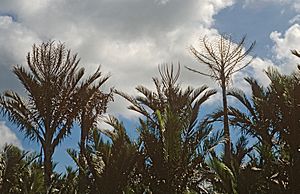Sago palm facts for kids
Quick facts for kids Sago palm |
|
|---|---|
 |
|
| Sago palms with characteristic terminal inflorescence/infructescence (West Seram, Maluku, Indonesia) | |
| Scientific classification | |
| Genus: |
Metroxylon
|
| Species: |
sagu
|
| Synonyms | |
|
|
The sago palm (scientific name: Metroxylon sagu) is a type of palm that grows in tropical parts of southeastern Asia. You can find it naturally in countries like Indonesia, Papua New Guinea, and Malaysia. It might also grow in the Philippines. This palm has also spread to other places like Thailand and the Solomon Islands.
The sago palm is very important because it's a main source of sago starch. This starch is used in many foods around the world.
Contents
What the Sago Palm Looks Like
The true sago palm grows in clumps, meaning it has many stems. Each stem flowers only once in its life. It grows a large, upright flower cluster at its top. A single stem can reach a height of 7 to 25 meters (about 23 to 82 feet).
Before a stem flowers, it has about 20 large leaves. These leaves can be up to 10 meters (33 feet) long. Each leaf is made up of many smaller leaflets, around 150 to 180 of them. These leaflets can be as long as 175 centimeters (about 5.7 feet).
The flower cluster itself is quite big, 3 to 7.5 meters (10 to 25 feet) tall and wide. It has many branches that curve upwards. On these branches, there are even more smaller branches. The flowers grow in pairs on the smallest branches. Each pair has one male flower and one flower that has both male and female parts.
After flowering, the palm produces fruit. The fruit looks like a drupe, which is a fleshy fruit with a hard pit inside, like a peach. It's about 5 centimeters (2 inches) wide and covered in scales. These scales start out bright green and turn straw-colored when the fruit is ripe.
Sago Palm in History
People have known about sago for a very long time. A Chinese historian named Zhao Rukuo wrote about it in his book Zhu Fan Zhi in 1225. This book described different countries. Zhao Rukuo mentioned that the kingdom of Boni (which is now Brunei) didn't grow wheat. Instead, they used "sha-hu" (sago) as their main grain. This shows how important sago was as a food source centuries ago.
How Sago Palms Are Used
The sago palm is very useful, especially for its starch. This starch is called sago. People get it from the trunk of the palm tree. They grind up the inside of the trunk and wash out the starch with water.
Sago starch is used in many ways in cooking:
- It's used to make puddings.
- It can be made into noodles and breads.
- It's also used as a thickener in various dishes.
In the Sepik River area of New Guinea, people make pancakes from sago. These pancakes are a very important part of their diet and are often eaten with fresh fish.
Besides food, parts of the sago palm are used for other things:
- The leaflets are used for thatch roofs. These roofs can last for up to five years.
- The dried leaf stalks, called gaba-gaba in Indonesia, are used to build walls and ceilings. They are very light, which also makes them good for building rafts.
Reproduction and Harvesting
Each stem of a sago palm flowers and produces fruit only once. After it flowers, that specific stem dies. However, the sago palm as a whole plant continues to live. It does this by growing new shoots, called suckers, from its base. These suckers grow into new stems.
To get the most starch from a sago palm, people cut down the stem just before or early in its final flowering stage. This is when the stem has the most starch stored inside. People usually grow new sago palms by taking these young suckers and replanting them, rather than by using seeds.
Scientists have found that the sago palm was a very important food source for ancient people living along the coast of China. This was even before they started growing rice.
See also
 In Spanish: Metroxylon sagu para niños
In Spanish: Metroxylon sagu para niños

